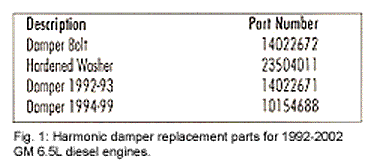Engine Builders: The AERA Technical Committee offers the following information regarding harmonic damper loosening, key shear and crankshaft damage on 1992-2002 GM 6.5L diesel engines. This condition has been reported on engines that have been in service a long time as well as engines shortly after re-installation of the harmonic damper.
In some instances, over time, the single bolt retaining the harmonic damper may lose its clamping load. A loose harmonic damper may eventually shear the alignment key, resulting in further damage to the crankshaft snout, keyway and damper mating surfaces. Continued engine operation may allow the damper to spin and relocate its position relative to the crankshaft keyway. Because this damper is balanced according to a specific location, it will cause a severe vibration if relocated 180° from the correct keyway location.
Since the crankshaft-timing sprocket uses its own key, the loose damper may not affect engine performance even when an engine vibration starts. If continued engine operation is allowed, component failure may occur. In some cases crankshaft breakage in this engine has been related to a loose or damaged harmonic damper.

GM also uses a hardened washer (p/n 23504011) under the damper retaining bolt head to assist in distributing the clamping load of the bolt. It is common practice for engine builders to replace this washer every time the damper bolt is removed from the crankshaft. The bolt securing the damper to the crankshaft is a 5/8? fine thread and requires an applied torque of 200 ft.lbs. According to one engine builder, it is actually good insurance to replace the bolt and damper as well anytime this engine is rebuilt. See Figure 1, for information.
Engine Builders: The AERA Technical Committee offers the following information regarding stripped spark plug threads on 1991-2003 Ford 4.6 and 5.4L engines. It has been reported that spark plug threads on these engines have become damaged at a rate that is significantly higher than on other aluminum cylinder heads. It appears the number of threads used to retain the plug (as few as four) may be insufficient for continued long-term use.
Since that design may limit the possibilities of different repairs, a solid insert offers the best opportunity of continued retention in the cylinder head casting. Currently there is a hard-anodized aluminum insert that is being reviewed by the Ford Motor Company for an authorized repair. This repair has been available for more than a year and has proven to be very durable.
These repairs are best made with the cylinder heads removed from the engine but reports of in-chassis repairs have been made. However, some engine builders report the engine can be removed and repaired faster than trying to make the repairs with the engine installed.
Most often, spark plugs remain installed in the engine for years at a time. Over time the threads may become almost locked to each other and the damage may occur when the plugs are hastily removed or reinstalled. It is suggested that spark plugs always be removed with the engine at room temperature after allowing a penetrating fluid to soak the threads.
It’s also been reported plugs that loosen while installed may “blow out,” taking the threads with them. This is one critical instance when the exact torque value of 11 ft.lbs. (14 Nm) is extremely important.
Caution: Inspect all spark plug threads when rebuilding these cylinder heads.
For information on receiving all of AERA’s regular monthly technical bulletins and other association services and benefits, call toll free 888-326-2372 or send an e-mail to [email protected]. AERA’s Web site is www.aera.org.













